On the Authenticity of the 1899 Mexican One Centavo
by Mike Dunigan
The first notice of fake 1899 Centavos was an article by Virgil Hancock published in his “Featuring Fakes” column (The Numismatist – April 1969). I copy below, verbatim, the portion of the Hancock article relating to the 1899 1 Centavo (thanks to the American Numismatic Association for permission to reprint a portion of Hancock’s column):
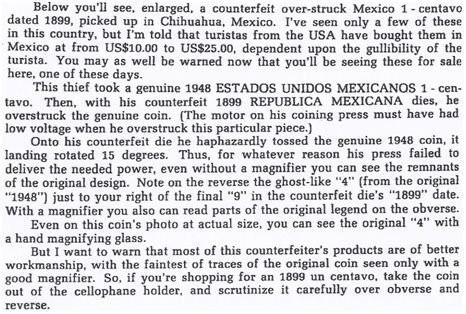 The photos referred to in Hancock’s article were too dark to reprint and really add nothing to the present discussion.
The photos referred to in Hancock’s article were too dark to reprint and really add nothing to the present discussion.
Hancock clearly stated that the fake 1899 1 Centavo was struck from counterfeited dies.
In an effort to bring some clarity to this matter I will address separately Counterfeit and Authentic 1899 1 Centavos by providing information through which the authenticity of any piece can be verified.
Characteristics of Authentic 1899 Centavos
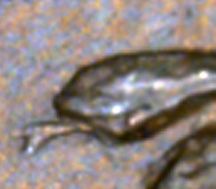 1. Forked tongue and clear oval snake’s head. As strange as this may sound, it may be the single quickest and reliable way to verify authenticity on higher grade specimens. I have never seen a counterfeit with a nicely formed snake’s head, much less a forked tongue, if any tongue at all.
1. Forked tongue and clear oval snake’s head. As strange as this may sound, it may be the single quickest and reliable way to verify authenticity on higher grade specimens. I have never seen a counterfeit with a nicely formed snake’s head, much less a forked tongue, if any tongue at all.
2. Softness of strike in the lower central portion of the obverse (bottom of 1¢) and the upper central portion of the reverse (upper portion of the eagle’s breast). The degree of softness can vary considerably from coin to coin. The greater degree of softness and most diagnostic point is on the lower left portion of the 1 and the lower left portion of the ¢, just below where the cross bar passes through the ¢. The 1 appears to fade into the ¢ sign at that point with no strong outline. All of the counterfeits I have seen feature a bold 1 with a strong outline from top to bottom.
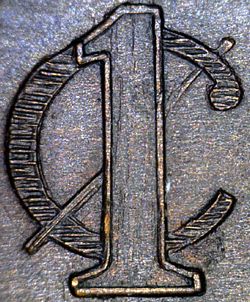
 3. As diagnostic as the forked tongue snake (but not as humorous) is the area on the ¢ sign between the lower portion of the down stroke (/) and the numeral 1. In this area there are no parallel lines as found on the rest of the C. This is not a function of softness of strike. The lines were engraved very weakly in the master hub, or that hub was damaged, and, therefore, do not appear (or barely appear) on the early coins of this series. These lines were not strengthened until 1903 or 1904. All counterfeit examples I have seen have these lines to a greater or lesser extent. The first counterfeit illustrated on p19 of Meyer’s article has the weakest presence of this detail that I have encountered. Although weak, possibly intentionally obliterated by the counterfeiter, there is still evidence that they were there. Most other counterfeits have strong lines throughout the C.
3. As diagnostic as the forked tongue snake (but not as humorous) is the area on the ¢ sign between the lower portion of the down stroke (/) and the numeral 1. In this area there are no parallel lines as found on the rest of the C. This is not a function of softness of strike. The lines were engraved very weakly in the master hub, or that hub was damaged, and, therefore, do not appear (or barely appear) on the early coins of this series. These lines were not strengthened until 1903 or 1904. All counterfeit examples I have seen have these lines to a greater or lesser extent. The first counterfeit illustrated on p19 of Meyer’s article has the weakest presence of this detail that I have encountered. Although weak, possibly intentionally obliterated by the counterfeiter, there is still evidence that they were there. Most other counterfeits have strong lines throughout the C.
4. On all authentic specimens I have seen the mint mark (M) is slanted upward to the left. The M on the counterfeits are, for the most part, centered or tilted up and to the right.
5. Overall style and quality. The authentic 1899 centavos are in terms of art, style and appearance superior to the counterfeits. On the reverse (eagle side)By Mexican law the eagle side of these coins is the obverse; however, most collectors and dealers consider the date side the obverse. For purposes of this article I am using the commonly accepted collector/dealer designation, date side –obverse, eagle side – reverse. the eagle’s feathers are tidy and finely executed, as is the wreath below. REPUBLICA MEXICANA is evenly punched with well-made letters. On the obverse (date side) the numerals of the date are clear and beginning with the first 9 drop down slightly from each other. The first 9 is slightly lower than the 8 and the second 9 is slightly lower than the first. In some cases counterfeiters have tried to reproduce this date position, but their numerals are normally crude and uneven.
6. If a collector is still not confident in his ability to recognize an authentic mint product, I suggest he carry a nice circulated example of a common 1900 Centavo. Then, when examining an 1899, he can compare the style characteristics as set out in this article. If they match, he is holding a genuine coin.
Below are pictures of five authentic 1899 centavos that I will analyze along with three other related coins.
Authentic 1899 Centavos and Related Coins
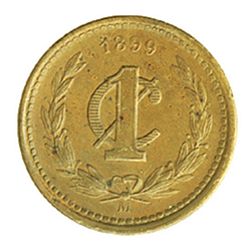
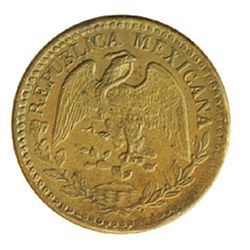
Authentic 1899 #1 A sharply struck example. There is a light die break on the top of the letter from B of REPUBLICA through M of MEXICANA.

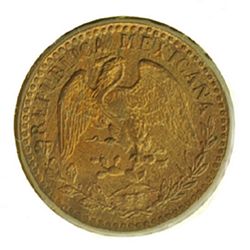
Authentic 1899 #2 This example exhibits the most mint red (whether real or not) of any 1899 that I have seen. The strike is exceptional. Very light planchet streaking is visible on both obverse and reverse. Evidence of die clashing can be seen across the upper portion of the reverse from the U of REPUBLICA, across the eagle’s head, to the C of MEXICANA.
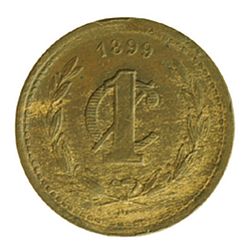
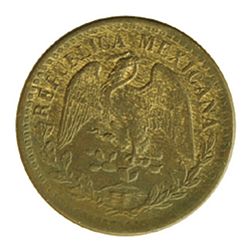
Authentic 1899 #3 Another well struck specimen. Planchet streaking is most visible on the obverse and present, although lighter, on the reverse. Evidence of out of collar striking (raised areas around the rim) can be seen around the obverse.
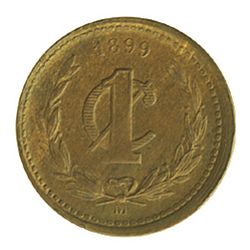
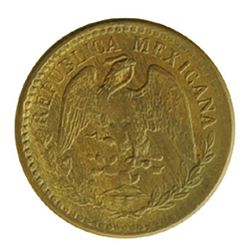
Authentic 1899 #4 A more typical soft center strike example of an 1899 Centavo. The reverse is a later die state of Auth 99 #1. The die break now extends from the bottom of the loop of the P of REPUBLICA, bisecting the U and continuing along the top of the letters to the C of MEXICANA. Another hairline die break extends from the wreath to the rim at the 4:00 position on the reverse. Once again there is evidence of out of collar striking around the obverse rim.
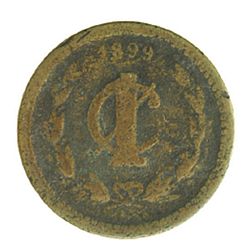
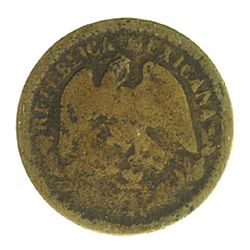
Authentic 1899 #5 Candidate for worst known of date! In theory this should be the most difficult to identify; however, let us examine the tell-tale markers. The date is clearly correct. The numeral 1 is of the correct style and in the right position. On the lower left portion the 1 fades into the C. Lettering of REPUBLICA MEXICANA is made from the correct lettering. The snakes head is of the proper shape although no tongue can be seen because of corrosion. Four check points correct without negatives = genuine 1899 Centavo.
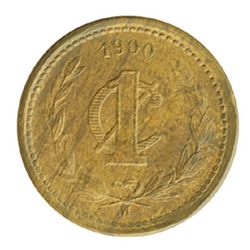
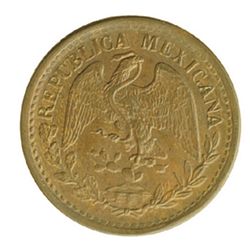
1900 M Light planchet streaking is present. This coin provides evidence that early small size centavos were sometimes struck on streaked planchets. Moreover, it goes to show that streaked planchets were not exclusive to the 1940s and certainly possible on 1899 Centavos.
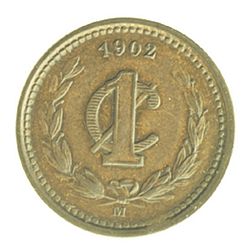
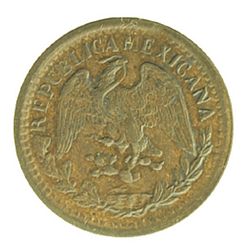
1902/899 M Note strong numeral 1 with bold outlines from top to bottom. This should help to dispel the notion that there was something wrong with the 1899 die(s). Die pressure was the sole cause for the difference in detail between this coin and the 1899s.
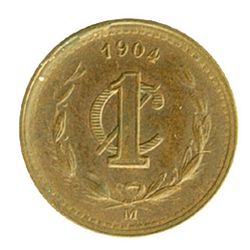
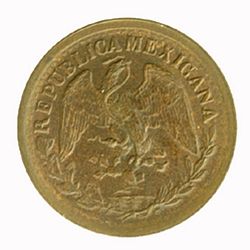
1904 M Note strong crossbar lines now present between the down stroke (/) of the ¢ monogram and the left out line of the numeral 1. This would point to the use of a new or reworked hub. This could have occurred as early as 1903.
Counterfeit 1899 Centavos
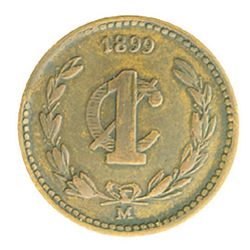
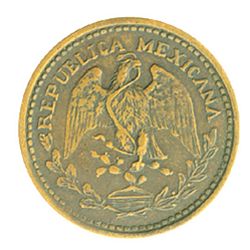
Fake 1899 #1 Note the close date. The numeral 1 has bold outlines throughout. There are crude cross bars throughout the C, including the area between the down stroke (/) and 1. The M is slanted upward on the right side, the opposite of genuine coins. On the reverse the sharp breast feathers of the eagle are crude, even amateurish, as is the water below the rock. The letter punches are also crude and uneven. The snake has no tongue.
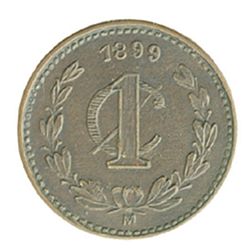
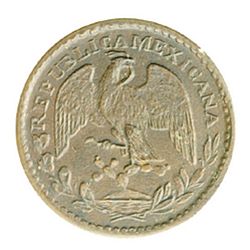
Fake 1899 #2 All details are very sharp including the entire outline of the 1 and the crossbars in the C between the down stroke (/) and the numeral 1. Of particular interest are the raised lines running vertically in the center of the 1. These are die polishing or die tooling lines that were never effaced. These are visible in the photo of the counterfeit die. On the date the last 9 is thick as if it has been repunched. The M is centered below the knot of the bow. On the reverse the letters are somewhat crude, as is the wreath. The eagle feathers are shallow and lack definition. There is a tiny head on the snake with a small single line for the tongue.
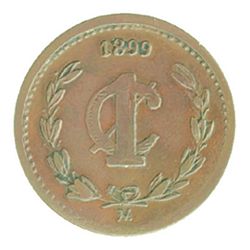
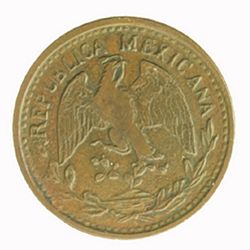
Fake 1899 #3 Smaller and “fatter” monogram 1¢, a closely spaced date and a crude left leaning M are all indications that this piece is counterfeit. The reverse features a completely flat eagle’s breast, possibly done to simulate what is often seen as authentic 1899’s. Crude, unevenly spaced lettering and poorly executed feathers in the eagle’s wing are additional indications that this piece was produced from counterfeit dies. The snake’s head is very crude and seems to have little or no tongue.
Fake Die - Counterfeit obverse die 1899 1 Centavo
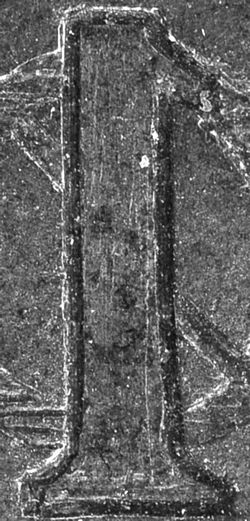
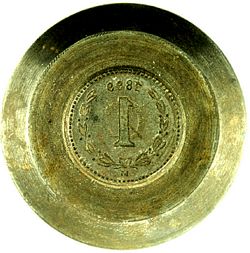 One of the “proudest possessions” from my Centavo Collection! This remarkable numismatic treasure was a gift from a friend of more than 45 years. This gentleman, now a retired coin dealer, lived at one time in the El Paso area (the major US trade port for Chihuahua). Although he is today uncertain of its source, he said he had owned it a long time and probably acquired it there. This appears to be the obverse die that struck Fake 99 #2. The evidence of this lies in the thick, probably repunched, second 9, the left leaning M, and, most significantly, the vertical lines in the numeral 1.
One of the “proudest possessions” from my Centavo Collection! This remarkable numismatic treasure was a gift from a friend of more than 45 years. This gentleman, now a retired coin dealer, lived at one time in the El Paso area (the major US trade port for Chihuahua). Although he is today uncertain of its source, he said he had owned it a long time and probably acquired it there. This appears to be the obverse die that struck Fake 99 #2. The evidence of this lies in the thick, probably repunched, second 9, the left leaning M, and, most significantly, the vertical lines in the numeral 1.
I realize that counterfeits exists struck from dies not illustrated in this article. That is really of little importance. If a collector learns how to identify authentic specimens, then anything else is just another fake. Other counterfeiting methods (other than die striking) do not, at this time, apply to 1899 Centavos.
Cast Fakes
I am sure these have been produced somewhere at some time, but I never recall seeing one.
Altered Date
This is impractical when it comes to 1899 Centavos. Most coins counterfeited by altering dates require change to only one digit (e.g. 5 Centavos 1931, 2 Centavos 1905, 1 Peso 1949, etc.). On the 1899 Centavo the counterfeiter would have to alter three of the four digits and would have no source for an 8 of the proper size and metal. This is more than three times the work
